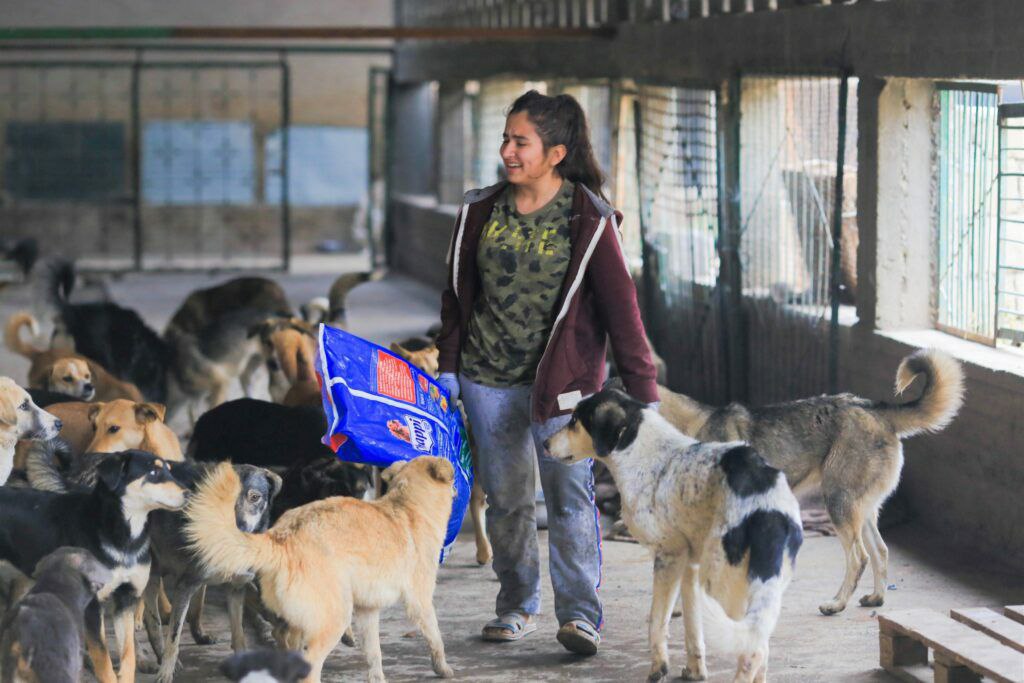Animal rights activists in Tajikistan demand to toughen punishment for animal cruelty and stop shooting stray dogs.

On April 13, 2022, the Parliament of Tajikistan adopted amendments and additions to the Law on Veterinary, which introduced the concept of a shelter for stray animals at the legislative level for the first time in the country. These amendments were adopted after animal rights activists repeatedly addressed the Dushanbe City Hall and related structures. Over the past few years, pet-loving city residents have united and made efforts to protect their four-legged friends. They submitted a petition to the Dushanbe Mayor requesting to organise a shelter for homeless animals in the city.
Even though the shelter has not yet been built, the efforts of animal rights activists have borne fruit – a concept of an animal shelter was introduced into the country’s legislation for the first time.
Through the efforts of local animal rights activists in Tajikistan, several private dog shelters have been built already. For example, there are two shelters called “Luchob” in Dushanbe, where more than 200 homeless animals, primarily dogs, are kept. There is also a shelter in Khujand city, Sughd region. Occasionally, some activists hold charity events and collect donations to feed these animals.
Interviewed animal rights activists found it difficult to determine the number of stray dogs.

“No one can tell their number because no one keeps records,” says Zulfiya Golubeva, a journalist and animal rights activist.
Earlier, the administration of Firdavsi district of the capital informed Golubeva that in 2018, public services caught 1,467 dogs. Of this number, only 6 dogs were taken home by the owners. They could not provide an exact number for 2018 in Shohmansur district of the capital but said that 50-70 dogs on average end up there each month.
According to another journalist and animal rights activist Aliya Khamidulina, there are “hundreds of dogs on the streets of the capital”.
The State Sanitary Epidemiological Surveillance Service of Tajikistan informed CABAR.asia that annually, about 12,000 cases of dog attacks on humans are registered. According to the Service, up to 15 people die from dog attacks annually.
What Are Animal Rights Activists Worried About?
Meanwhile, animal rights activists often publish photos and videos of shootings and “hunting” for dogs in Dushanbe, both by responsible structures and individuals. Animal rights activists are worried about the brutal attitude toward dogs and other homeless animals noting that they are often tortured or even killed.
Zulfiya Golubeva publishes articles on animal protection on animalals.vecherka.tj resource for more than a year. She says the number of stray dogs is increasing largely due to irresponsible owners. People throw dogs and cats out into the street because they are “tired, played with them enough, or are moving”. The people’s cruelty towards homeless animals aggravates the situation.
“People beat them, torture them, and often, brutally kill them. These violent acts almost always remain unpunished, so the value of the animal’s life means nothing,” Golubeva said.
The animal rights activist says the people’s sadistic attitude towards animals on the street scares her.
“Cruelty among the population is alarming,” Golubeva said.
Journalist Aliya Khamidulina also believes that the situation with stray dogs in Tajikistan is close to disastrous.
“The single way they are trying to fight them is shootings. However, that does not help the situation. The dogs breed randomly and the problem is not solved. The life of stray dogs on the streets is a constant struggle for survival: the constant search for food, fear of humans, painful death from shooting,” Khamidulina said.
Meanwhile, the country’s legislation does not provide for punishment for infliction of harm to domestic animals. In the case of killing them, the Code of Administrative Offenses of Tajikistan provides for a fine in the amount of 3 to 5 minimum calculation indices. Currently, one such indicator is 64 somoni (about $6.5) in the country.
Animal rights activists demand to toughen the punishment and punish those who torture domestic animals.
Occasionally, the authorities report on arrests and prosecutions of individuals involved in cruelty to dogs. In particular, on June 2, the Dushanbe Department of Internal Affairs published a statement about the detention of a capital resident, 31, who was fined for animal cruelty.
Stray Dogs’ Attacks
Simultaneously, the residents of the country and officials often say that stray dogs pose a danger to people’s health and there is a high chance of their attacks on people, especially women and children. The risk of spreading infectious diseases by homeless animals is also high.
Dushanbe resident Safargul Karimova complains about the increase in the number of stray dogs in the capital. According to her, children wake up in fear at night from the dogs’ barking; dogs gather in packs and scare lonely passers-by on the streets.
“Some time ago, a stray dog attacked a neighbour’s child and bit him. The child was immediately taken to the hospital. Fortunately, the dog was not rabid. We addressed the apartment complex manager, the mahalla’s head, and even the district’s head many times requesting to take measures to ensure the children’s safety. However, neither the mahalla’s head nor the district’s head has done anything so far,” she complains.
Another Dushanbe resident Naim Karimov also expressed concern about the increase in the number of stray dogs in the capital and said that several years ago, his daughter fell ill from fright because of such dogs.
“My daughter went to the pharmacy to buy medicines at night. When she was returning, she ran into a pack of stray dogs. They did not attack her but she stopped in fright and could not cross the street to return home,” Karimov said.
Worried about the long absence of his daughter, he went out and saw that she was standing frozen in fear and crying. He shooed the dogs away and brought his daughter home.
Since then, his daughter often wakes up in fear at night. She received medical treatment for about a year but nothing helped.
“She wakes up in fear almost every night. She cannot go anywhere alone and talks to herself sometimes. The doctors said that she was very frightened,” the man added.
Another Dushanbe resident Hikmatullo Raupov says he often sees packs of stray dogs at night or early in the morning.
“We live in a city and people here are constantly moving both at night and during the day. Someone goes to the night shift; someone comes back from work. It is especially dangerous when children go to school early in the morning,” Raupov says.
According to him, stray dogs are especially dangerous during winter, when they can no longer find food and are starving.
“Therefore, they must be liquidated so that citizens can go outside freely and without fear,” he said.
The officials say that the children most often become victims of attacks by sick dogs.
Is There Another Way Except Killing?
In the capital of Tajikistan, the responsibility for trapping stray and sick dogs lies with the road and utility services of the four capital districts. They hire a group of ‘hunters’, who catch dogs in special raids from 3 to 5 AM when the streets of the city are empty.
According to the rules, the captured dogs are kept in special places in these institutions for up to 3 days.
An employee of the Public Roads Administration of Ismoili Somoni district anonymously told CABAR.asia that the animals are sent to specially designated places if the owners of the dogs are not found.
“Basically, the dogs that walk the streets without a muzzle and collar, without an owner, are considered stray dogs. To ensure the sanitary and epidemiological safety of the population, the special services catch and take them to special places, where they are kept until their owners are found. If their owners are not found, the animals are neutralised,” said the source.
Lately, the country’s residents actively discuss and express concern about the cases of the shooting of dogs and animal cruelty. In particular, last year, the news about the killing and burning of 700 dogs in Bokhtar city, the centre of Khatlon region, caused outrage among animal rights activists. Officials said at the time that the dogs were dangerous and that they had no choice but to kill and burn them.
The services say that they still have no other choice but to take stray animals to a landfill outside the city. Otherwise, the risks of attacks on people and a rise in rabies incidence increase.
An Increase in the Number of Stray Dogs is People’s Fault
According to the experts, people are often to blame for such situations, as they are irresponsible in keeping animals and caring for them.

Dilshod Boltaev, a Tajik veterinarian, believes that people’s irresponsibility is the reason for the increase in the number of stray dogs. Some people adopt a dog for a while, as a living toy for their children or themselves, and then, throw it out into the street. Abandoned dogs gather in packs and pose a threat to society.
“First, it is necessary to educate society so that people become responsible for dogs. This is the main reason for the increase in the number of stray dogs; it is not because of the dogs breeding on the streets. The media should explain to the population that such actions pose a danger to society and people around them,” Boltaev said.
Other countries also try to solve this problem in different ways. In some parts of the world, this problem is solved by organising shelters, while in others, animals are sterilised by surgical procedures, thus, it prevents an increase in the number of stray dogs.
The New Law Is a Step Towards Stray Dogs Protection
The amendments to the Law on Veterinary introduced this April are the result of the work of several members of Parliament and a working group created by the Vecherka media company and the “Peshsaf” NGO to initiate legislative changes in state’s and society’s relation to animals.
Such concepts as stray animals, animal cruelty, and animal shelter are introduced for the first time.
In addition, the draft amendments to the Law on Veterinary define the concept of humane treatment of animals, the criteria of which is the well-being of animals and humans in accordance with the generally accepted ethical values, as well as the protection of animals from cruelty, and a responsible attitude to their life and health. The amendments also include the regulation of the treatment of stray animals and the rules for the shelters’ functioning – they can be public and private in any organisational and legal form.
Aliya Khamidulina believes that the creation of shelters solves the problems with homeless animals only partially. She notes that this is expensive since dogs must be kept in the proper conditions, fed, and medically treated. Shelters have to hire employees and pay salaries.
“Even in developed countries, public shelters cannot keep dogs for their entire lives. Dogs that are not adopted are euthanised,” she said.
Zulfiya Golubeva also believes that additional legislative acts are needed for this law to work.
“I am not a lawyer but I know that the by-laws are needed to describe in detail the procedure for its [the Law] implementation. That is, who will be responsible for the construction of the shelter? What it should be like? How many shelters should be constructed? It should describe the entire work of the shelter: what, how, and how much? And the most important question: who will fund these shelters? We can say that the introduction of these amendments has not resolved the problem yet. The resolution is still far away,” said Golubeva.
Why Are Dogs Dangerous?
Veterinarian Rahmon Boltaev proposes to open places for the temporary keeping of dogs in the country. Another way is to build shelters for stray dogs, which will allow them to find a home there and reduce the threat to society.
In 2018, when the situation with the shooting of animals on the streets of Dushanbe escalated, animal rights activists filed a complaint with the Dushanbe Department of Internal Affairs about the illegal and inhumane actions of the public services’ employees. In their complaint, the authors referred to Article 277 “Animal and bird cruelty” and Article 278 “Slaughter of animals and birds in unpermitted places” of the Code of Administrative Offenses of Tajikistan.
The police considered this complaint and the public services’ employees were fined under Article 277 for about 200 somoni (about $20). Article 278 indicated in the complaint (“Slaughter of animals in unpermitted places”) was ignored and no one was punished for this (perhaps due to the high fine for it).
Meanwhile, according to the Tajik lawyers, the new draft Criminal Code will include an article on animal cruelty and establish punishment for it.
“An obligatory condition, an obligatory criterion will be cruelty, hooligan motives, namely sadism,” says lawyer Dilshod Juraev, who looked through the draft law. “The usual euthanasia of animals will not be included: after all, we euthanise animals for humane reasons.”
According to Juraev, the minimum punishment for animal cruelty will be about $450, and the maximum is fifty days of arrest.
“The practice will show whether this will be enough,” the lawyer notes.

According to Aliya Khamidulina, the only humane solution to the problem of homeless animals is their mass sterilisation and castration. Of course, the dogs that live on the street must be healthy and not pose a danger to society.
As an example, she talks about Turkey, where stray dogs and cats are sterilised and microchipped. They peacefully coexist with people and are a part of the city’s ecosystem. People do not abuse them, feed them, and treat them with respect.
“The authorities must find a humane way and the experience of developed countries in this regard can be an example. Dogs that pose a threat to humans, such as those with rabies, must be liquidated. Again, in a humane way only – by euthanasia. This requires high-quality work of animal control, veterinary services, and clinics. Dangerous animals should be euthanised, healthy ones – castrated/sterilised, microchipped, and released back into their habitat. The microchips will allow people to determine that the animal is not dangerous; they can pet it, play with it, or even take it home,” Khamidulina said.
Zulfiya Golubeva believes that, first, it is necessary to identify whether the dog has rabies or not.
“For some reason, people believe that a dog that has bitten a person must have rabies. That is not always true. In early 2019, when I interviewed the director of the veterinary service of Dushanbe, he said that in 2018, not a single case of rabies was detected in the capital,” Golubeva said.
Nevertheless, dogs with suspected rabies were brought to the service several times. The fate of these animals was tragic.
“They were all killed to do an accurate test. An accurate diagnosis can only be established by doing a test of the brain. It turns out that rabies was never found and the animals were killed for nothing,” she said.
Golubeva also considers it necessary to control the reproduction of domestic animals, to introduce responsibility for those owners who throw animals out and for those who breed animals for sale.
Another very important measure is to educate the population. Golubeva believes that the aggressive behaviour of animals is a consequence of a cruel attitude towards them.
“It is not their fault that they were born. They cannot speak, cannot understand us, cannot understand what we want from them. However, they will definitely understand a kind and merciful attitude. We, the most intelligent beings on the planet, need to learn to understand them and coexist with them. This is their planet too. We did not bring them to this world and it is not up to us to decide whether they live or not,” concluded Golubeva.

